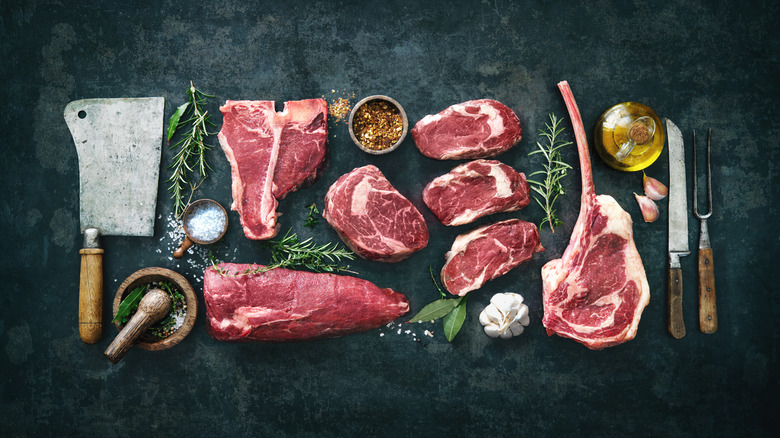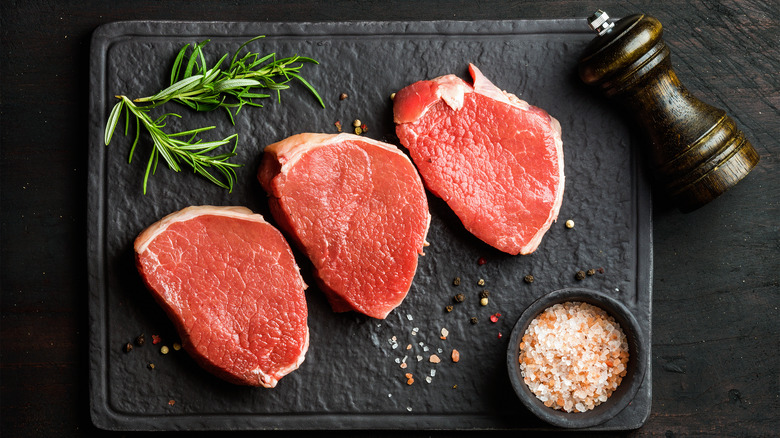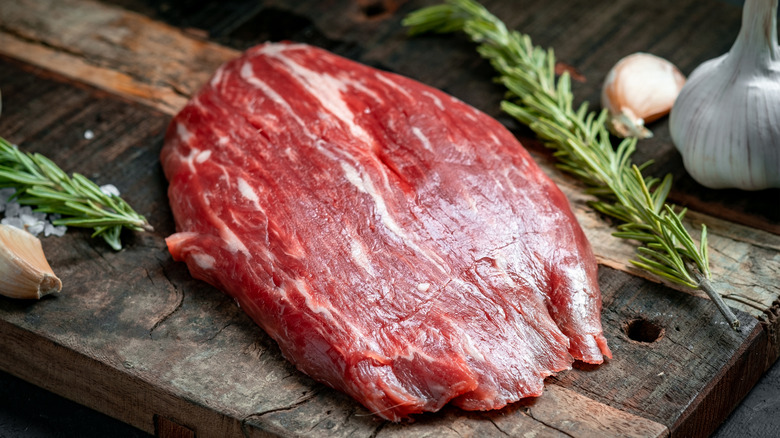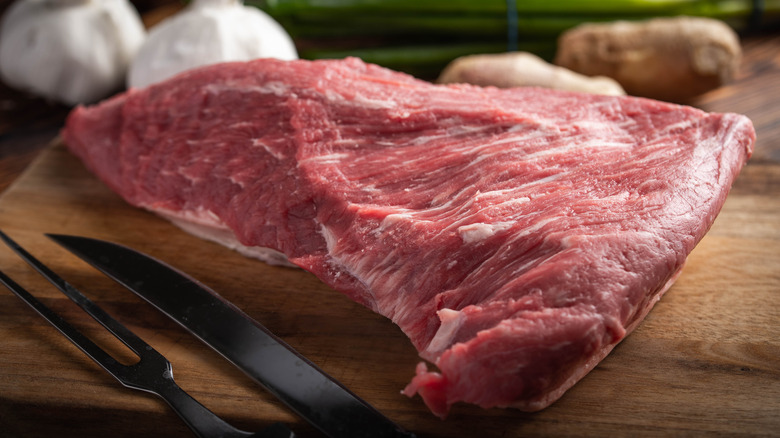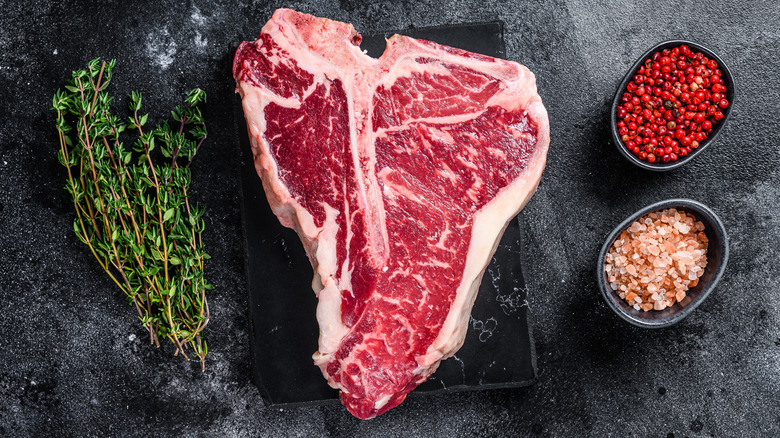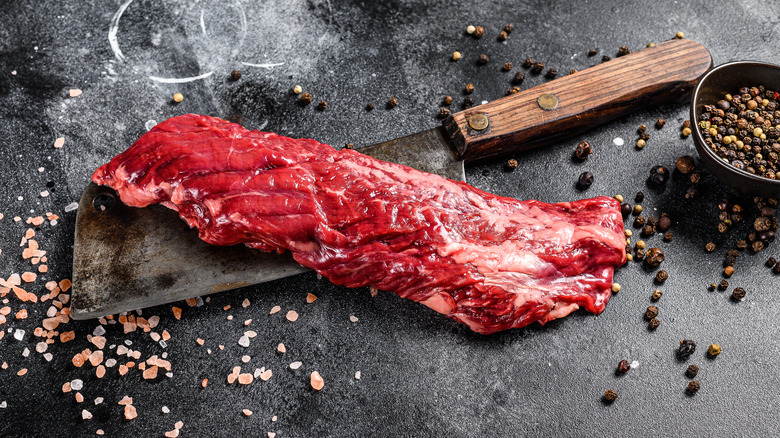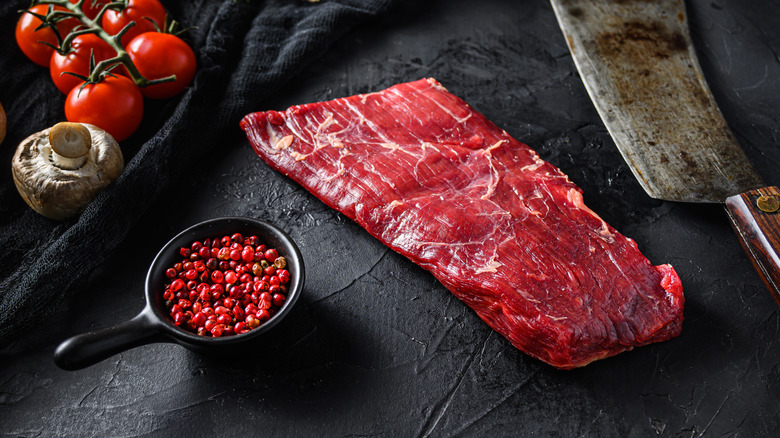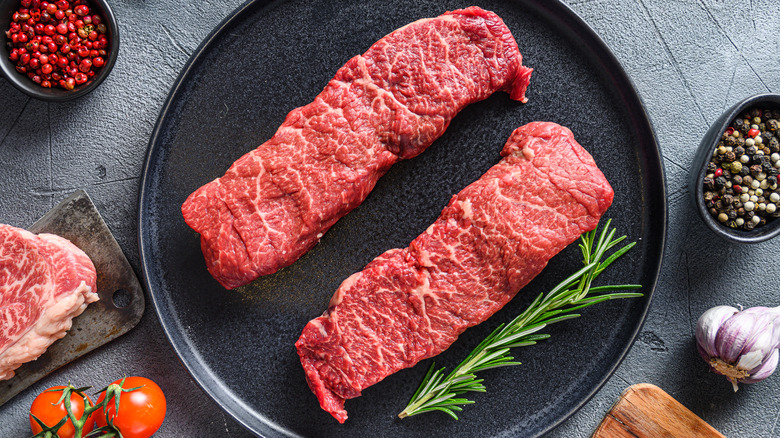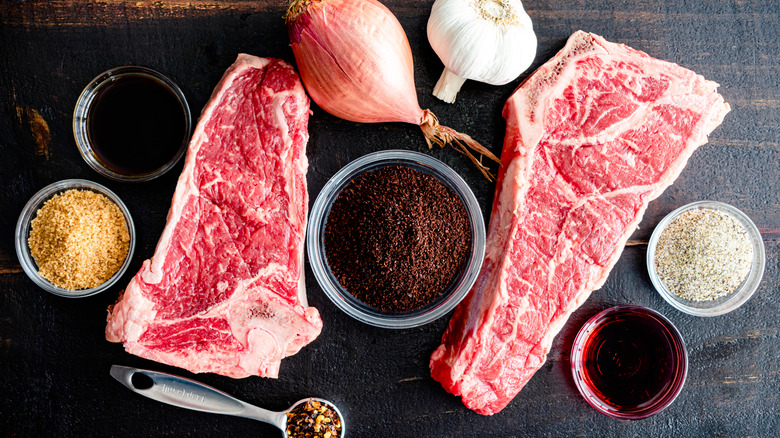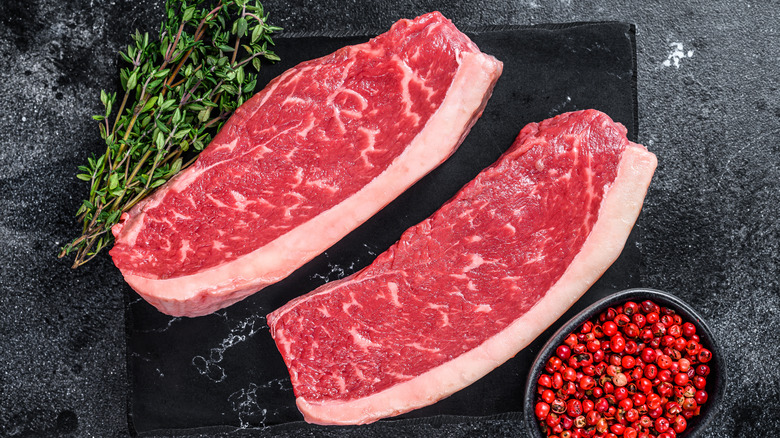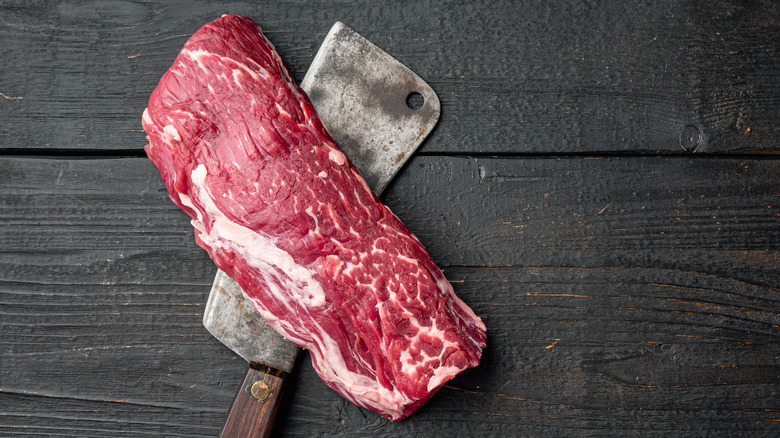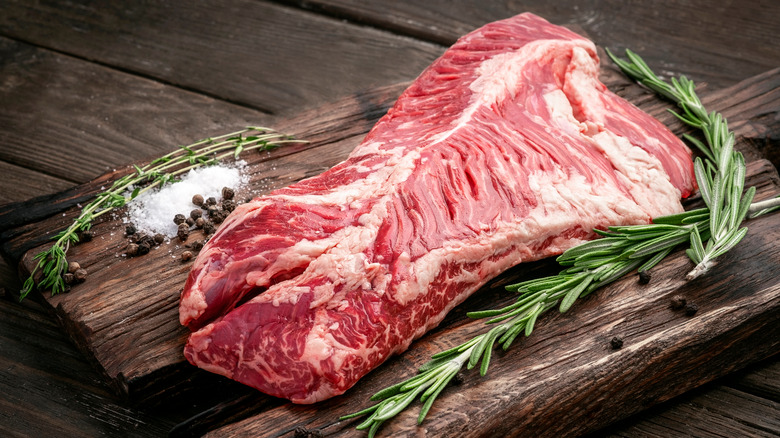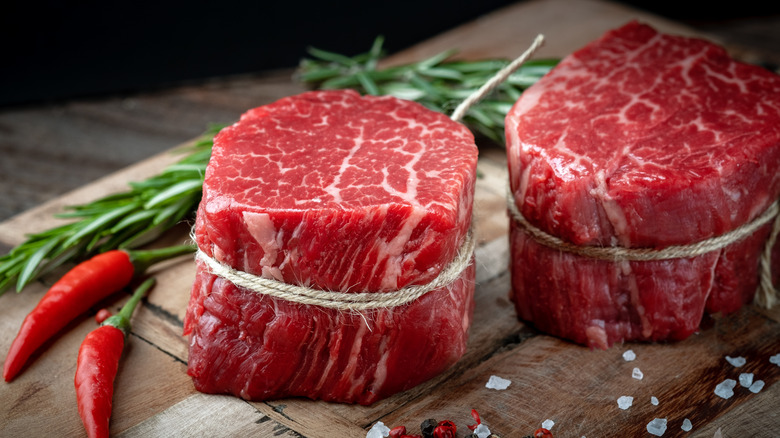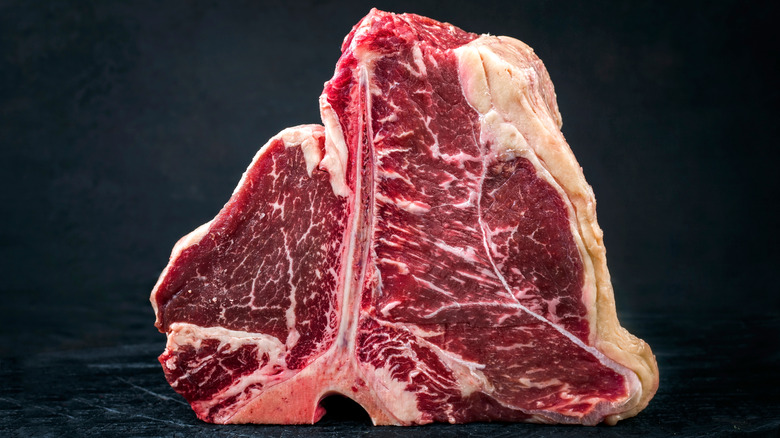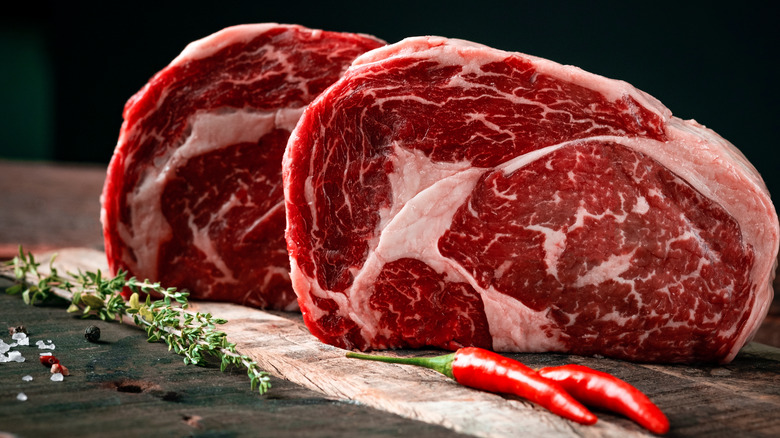The Most Popular Cuts Of Steak Ranked Worst To Best
Analyzing the meat section of your local grocer or the shelves at your nearby butcher shop can be confusing. Steak comes in a wide variety of different cuts, tenderness, flavors, required cooking methods, and price points. We know red meat should be enjoyed in moderation, which is good news for both your dietary health and minimizing contributions to harmful environmental emissions. Also, the price of red meat has grown considerably over the past couple years because of imbalances in supply and demand, according to Forbes. Nowadays, you may be paying more for your next cut of steak, which is why you need to know what you're looking for.
Steak can be an easily accessible option or more special once-in-a-while treat. There are steaks that are fit for one of those occasions and some that fit both. The important thing is, you end up getting a quality steak that is the best bang for your buck. This ranking will help you determine the best cut of steak for you, your purpose, and your wallet.
14. Round Steak
Round steak is taken from the upper rear of the cow. Round steaks can be sold as a top round cut, bottom round cut, or an eye of the round cut. According to The Spruce Eats, round steaks tend to have the least fat marbling, making them very tough and less flavorful than steaks coming from other parts of the cow.
Because this cut is 100% muscle, round steaks cannot be cooked quickly with high heat like their fattier counterparts. Instead, they must be cooked on a very low heat setting for an extended amount of time. Plus, most round steak recipes call for the addition of other moisture.
While it is true any steak seasoned and cooked properly will yield a tasty result, these characteristics make round steaks not fit for the grill at your next barbecue, a stove top skillet, or even a reverse sear roast in the oven (via Food Fire Friends). Subsequently, round steaks are also not a convenient option for a quick and easy weeknight dinner. Cooking round steaks well takes a lot of time and a more intensive effort.
Furthermore, any flavor of round steaks comes from foreign elements like seasonings or braising liquids, which makes them a poor choice when craving the hearty, meaty taste that most other cuts of steak can provide. While round steaks cost far less than more flavorful, less involved steak options, the monetary advantage does not supersede its many shortcomings.
13. Flank Steak
Flank steaks are another muscle-y, cost-efficient cut, but their versatility does help to balance out their toughness. Flank steaks come from the flank of the cow, which sits below the tenderloin and sirloin along the underbelly, according to Food Fire Friends. Because of this location on the abdomen, flank steaks are tougher because of their exercise whenever the steer walks or turns its body. The intensive work of the muscle can actually be seen on a cut of flank steak. Its long, thick muscle fibers and low fat content are a sign of its constant use. Although this cut sits in an area of the steer surrounded by fat, the flank itself remains very lean.
Flank steak's toughness can be minimized depending on how it is cooked but slower braises will not break down the muscle fibers of the steak well enough, which will keep the cut chewy. Cooking a flank steak fast on high heat will help break down the fibers better by retaining more moisture. Slicing the flank steak thin, across the grain will also help break down these muscle fibers and yield a more tender, juicy, flavorful final product. Flank steak also takes very well to marinades. The longer the marinade, the better the steak.
Like round steaks, however, the flank steak requires a lot of additional components to meet its full potential. Flank steak can be a delicious, less expensive option, but the quality does not come with the steak alone. It comes with your own effort.
12. Tri-Tip
The tri-tip comes from the tri-tip roast, which is cut from the bottom, leaner portion of the sirloin, per Taste of Home. This triangular shaped cut is at its best when over high heat and to an internal temperature below medium. Although the bottom sirloin is generally tough and muscle-y, the tri-tip comes from the part of the bottom sirloin that usually includes specks of fat and marbling. The fat content is not high, however, so seasoning and cooking method is key (via Better Homes & Gardens).
Tri-tips can be grilled, seared in a pan on the stovetop, oven-roasted or even broiled. Grilling is your best option, however, as the higher heat capability combined with the smokiness helps add another layer of flavor that makes up for this cut's lack of fat.
Tri-tips are normally available as whole cuts or sliced and packaged into individual portions. Either way, the tri-tip is an inexpensive steak option that will satisfy your meat craving if prepared and cooked properly. More flavorful cuts within the same price range do, however, remain smarter, more delicious choices.
11. T-Bone
T-bone steak may be the most overrated cut there is. According to Omaha Steaks, T-bone steaks are cut as a cross-section of the short loin and therefore contain part of the tenderloin, or filet mignon, as well as the short loin, or NY Strip, each of which is separated and held together by the same bone.
There is, however, a common misunderstanding regarding the amount and the quality that exists in a T-bone cut. Many mistakenly believe porterhouses and T-bones are interchangeable but this is not the case, as Steak Revolution explains, and it's certain porterhouses would take offense to that widely held belief.
There are between six and seven T-bone cuts available from one cow, and only two or three porterhouses (via Omaha Steaks). Plus, many T-bone steaks are cut where the NY Strip collides with the top sirloin, resulting in an inedible piece of sinew. While the NY Strip is a delicious and low maintenance cut of steak, the idea that the T-bone grants you two cuts in one is not exactly the case. When you pick out a T-bone, you end up paying more for less.
10. Skirt Steak
Skirt steak and flank steak are very similar, but skirt steak does come out on top for a variety of reasons. According to The Kitchn, skirt steak also comes from the abdomen of the cow, but skirt steak actually comes from the diaphragm, which makes it another hyperactive, tougher cut. Skirt steak does have a more beefy flavor than flank steak, but it does have more muscle fiber, so high heat, quick cooking methods are also the best for optimal tenderness. Skirt steak is also perfect for long marinades and should be sliced as thinly as possible across the grain.
Skirt steak usually has a higher fat content, which is what sets skirt steak above flank, according to Cooking Light. This extra fat helps balance out the stronger muscle fibers and a proper rendering of that fat contributes to the more meaty flavor. If you've ever had Mexican fajitas, you've probably had skirt steak, so you know how delicious it could be.
9. Flat Iron
Flat iron steak is another great vehicle for marinades as well as serving larger groups of people. Plus, their higher fat content and evenly distributed marbling make for a juicier, more flavorful steak that can be cooked to a more widely enjoyed doneness without the sacrifice of tenderness or taste.
The tenderness and flavor found in a flat iron steak is in part due to the cut coming from the shoulder of the steer, also commonly referred to as the "chuck," according to The Spruce Eats. As opposed to the abdominal region flank and skirt steaks are cut from, the chuck is a more relaxed area of the cow which correlates to a more tender bite. Additionally, flat iron steaks are cut from a more fatty part of the chuck, known as the top blade roast. The tough, connective tissue that runs through the top blade roast separates the top blade and the flat iron. Once it is removed, the flat iron is freed from the toughness.
Flat iron steaks are available in rectangular shapes similar to flank steaks, but their thickness is uniform (via Food Fire Friends). This makes for a more even cooking best suited for the backyard grill. While flat iron steaks contain more fat, flavor, and better texture, their cost reflects such. While a flat iron steak is nowhere close to the most expensive there is, it will cost more than comparable cuts like its predecessor on this list.
8. Denver Steak
The Denver steak is the youngest on this list. It's strange to think that parts of a cow can vary in age, but the Denver cut was not actually discovered until an investigation was conducted by a group of professional butchers from the Cattleman's Beef Board in 2009, according to Grill Master University. The task was to find a cut of meat from the chuck roll in the cow's shoulder. While cuts from the chuck are typically cooked at low temperatures for long amounts of time such as in braises and stews, the result of the project was a cut fit for a high-heat grill that remains juicy, tender, and delicious.
The Denver steak and flat iron steak are very similar. They both come from the chuck of the steer, but while the flat-iron is part of the top blade roast, the Denver steak is found below the blade altogether. This area of the chuck is exercised even less than the bottom half of the top blade, therefore containing more fat marbling despite not having a fat cap. The Denver cut also comes in a rectangular shape and is cut very thin, so cooking methods must correlate for best results.
Denver steaks are hard to find, usually only available from an established butcher and not so much at the supermarket, per Taste of Home. That being said, Denver steaks do cost more money than those more readily accessible, but the taste and uniqueness does make up for the few extra dollars.
7. New York Strip
New York Strip comes from the shorter side of the cow's loin, according to Ruth's Chris Steak House. This area of the steer is more often relaxed and is not very active, making NY Strip marbled with some fat, fuller bodied, and richer in flavor. NY Strips can also be purchased and cooked on the bone, adding a further element of potential flavor and presentation. NY Strips are typically available in 16-ounce cuts, but can be cut to larger sizes depending on your butcher or your liking.
The fat content of NY Strips makes them accessible to quick and simple stovetop sears, reverse searing or being tossed on the grill. These steaks are also the first on our list with a distinct ability to be paired with a wine, particularly a wide variety. Because NY Strip steaks hold a balance between tenderness and texture, red wines like Cabernet Sauvignons and Bordeauxs have a higher level of tannins, which soften as they bind with the fat of the steak. These red wines are also more acidic, which helps to cut fat.
NY Strip does carry many great qualities and remains a cost-efficient steak option. However, the NY Strip checks these boxes at a very basic level. Its fat marbling, cooking method, potential wine accompaniments, etc. are amplified in other cuts of steak from more relaxed areas of the steer that come in larger, not too much more expensive portions.
6. Top Sirloin
The sirloin is split into two different sections, top sirloin and bottom sirloin, two cuts that lie above and below the tenderloin, according to Food Fire Friends. Sirloin steak comes from the area of the cow between the last rib all the way to the hip bone. Bottom sirloin is very muscle-y and therefore quite tough and is normally only used for ground beef. Top sirloin, on the other hand, is a more relaxed cut, is marbled with more fat and is far more tender and juicy, which is why it s one of the most popular cuts of steak on both restaurant menus and market shelves alike. There are many different cuts of sirloin including the sirloin flap and sirloin tips, but top sirloin remains the leader of the pack.
Legend has it sirloin got its name from King Henry VIII, who was so impressed by the steak he decided to knight it, declaring, "Loin, we dub thee knight; henceforward be Sir Loin," a title well deserved (via The Vintage News). Although top sirloin is a leaner cut of steak, it can be available with a fat cap still on. If rendered properly, the fat cap will make up for any lack of fat marbling that can be found in richer cuts.
Even without the cap, however, top sirloin is far more tender than cuts lower on our list, and will yield a soft, juicy product if cooked to a temperature of medium-rare to rare. Sirloin steak is another great individually portioned cut well suited for simple high-heat cooking methods.
5. Bavette
Also known as flap steak, bavette is a flat cut with an intense beef flavor. According to Steak Revolution, the bavette is also known as the butcher's cut, because butcher's often save it for themselves. The name "bavette" is the French word for "bib," since this cut comes from the lower chest area of the cow close to the top of the abdomen. This well exercised but still fatty part of the cow makes bavette versatile, in addition to delicious. Bavette should contain a significant amount of fat, which is why it can be well enjoyed in a variety of forms from sliced thin to simply seasoned and cooked whole.
Bavettes have a similar flavor profile to flank or skirt steak, two other flat cuts found close by, per Food Fire Friends. Bavettes are packed with minerals and are dense with fiber. Bavette, however, has a very loose structure, helping to avoid chewiness or toughness with a lot of wiggle room in cooking method and internal temperature. This loose structure also lends itself to seasoning rubs and marinades, and the opened muscle fibers are able to catch and hold any flavorful accouterments.
Bavette and flank steak are actually commonly mistaken for one another; but as Steak Revolution explains, the difference, however, goes a long way in flavor, texture, and price. Bavette steak can most likely only be found at a butcher shop, just as long as they haven't already reserved it for themselves. If you do find bavette available, seize the opportunity and give it a try.
4. Hanger Steak
Hanger steak is rare on most supermarket shelves, but that's not because it is low quality. In fact, hanger steak is often referred to as "the butcher's secret" because of its exceptional quality and lower level of popularity, according to MyRecipes. Hanger steaks are another cut from the stear's diaphragm, but from a more relaxed area, giving it more fat marbling. Hanger steak has a richness that can rival the most high-end steak you can find yet remains super tender. The only problem is it's difficult to find.
Your local grocer or supermarket chain probably won't have hanger steak packaged and stocked in the meat section, but that's only because it would be impractical to do so. This is because for every cow, there is only one hanger steak. So, for a grocer to stock their shelves with a dozen hanger steaks, for example, they'd have to purchase a dozen cows. This makes hanger steak a more expensive cut, but the extra monetary contribution will pay many dividends. Hanger steak's abundant amount of fat makes it an easy cut to cook, only requiring minimal seasoning and a short amount of time on a high-heat setting.
Further, as MyRecipes explains, another reason why you may have only ever encountered hanger steak at a restaurant is because most people are not familiar with it. Grocers only stock products they know people will purchase. Luckily, your local butcher is sure to have a cut of hanger steak available for you, and chances are they'll be glad you are interested.
3. Filet Mignon
Filet Mignon is undoubtedly the most widely encountered cut of steak there is. Filet mignon is portioned out of the tenderloin, which is cut from the short loin of the cow and is completely surrounded by very relaxed muscles that rarely get exercise, according to Delishably. This is what makes this cut iconically lean and tender. Cuts of filet mignon are cut into two-inch-thick portions from the entire tenderloin, but the true filet mignon comes from the extra tender, smaller tip of the tenderloin.
Despite filet mignon's popularity, it remains a more costly cut of steak as its availability is limited to only a few portions per cow. Additionally, cost can also vary on the raising of the cow itself, which does in fact make for substantial difference in flavor and texture. Grass-fed beef yields a more premium cut than their more traditional and more widely practiced grain-fed counterparts. The extra cost, which can range between an additional $5 t0 $10 per pound, does contribute to a richer, more nutritious and more humane cut of beef. In an era when your carbon footprint can and should be minimized as much as possible, grass-fed filet mignon is a win-win-win option.
The fat marbling of filet mignon cuts is so evenly dispersed and unfettered by constant exercise the only needed preparation to indulge in its richness is to season with salt and cook. That's it. Hearing the words "filet mignon" immediately communicates luxury, and the beautiful simplicity of this cut of steak is the reason why.
2. Porterhouse
With so many cuts of steak to choose from and a choice of characteristics that come with each, the porterhouse encapsulates the best of them all in one. Porterhouses are cut from the junction connecting the tenderloin and top loin (NY Strip), according to Cattlemens Restaurant. Porterhouses are bone-in cuts in the shape of a letter "t," but they are not the same as T-bones.
Although both the T-bone and porterhouse are cut from the same area of the cow, their ratio between the tenderloin and top loin they connect differs drastically. T-bones are cut in favor of the top loin, leaving a very insignificant amount of tenderloin on the bone. Porterhouses, on the other hand, are center cut, evenly inclusive to the rich, buttery NY Strip on one side of the bone, and a succulent, tender filet mignon on the other.
Porterhouses are high in price but their quality and size make up for their monetary sacrifice. One porterhouse steak can weigh up to two pounds, easily fit to fulfill two servings. Like the filet mignon sitting on one side of the bone, porterhouses are fit for simple seasonings and quick, high-heat cooking, but the result will be a combination of lean tenderness and rich dense flavor. The porterhouse is the best of both worlds, no wonder it's known as "the king of the steakhouse."
1. Ribeye
Of all the many options that lay before you at the butcher or the supermarket, there is no cut that provides more value to your dollar than the ribeye. While cuts of ribeye are priced higher than most other individually packaged steaks, ribeyes are actually less expensive than their two predecessors on this list. Plus, their flavor and simplicity make it far worth your while.
Ribeyes are cut directly from the ribcage of the cow. According to My Chicago Steak, the copious amounts of fat on the rib cage provide a depth of flavor completely unparalleled by any other cut of steak. Not only is the ribeye surrounded by flavorful fat, it's marbled by it end to end. This fat melts down and opens up the fibers of the ribeye, allowing it to absorb all of the flavor brought to life by your ripping hot stovetop skillet. Ribeyes can be available on the bone (Tomahawk) or boneless. Either way, there is no lack of decadence.
Ribeye steaks also take particularly well to dry aging, a process that adds both tenderness and flavor to a cut of steak by storing the steak in a temperature controlled environment for an extended period of time. It is understood dry-aged ribeye is only available at higher end steakhouses and probably not in your own home (via Serious Eats), but when the opportunity presents itself, the decision to take advantage should most definitely be considered. The experience of eating that steak will cause you to forget the extra dollars spent doing so.
